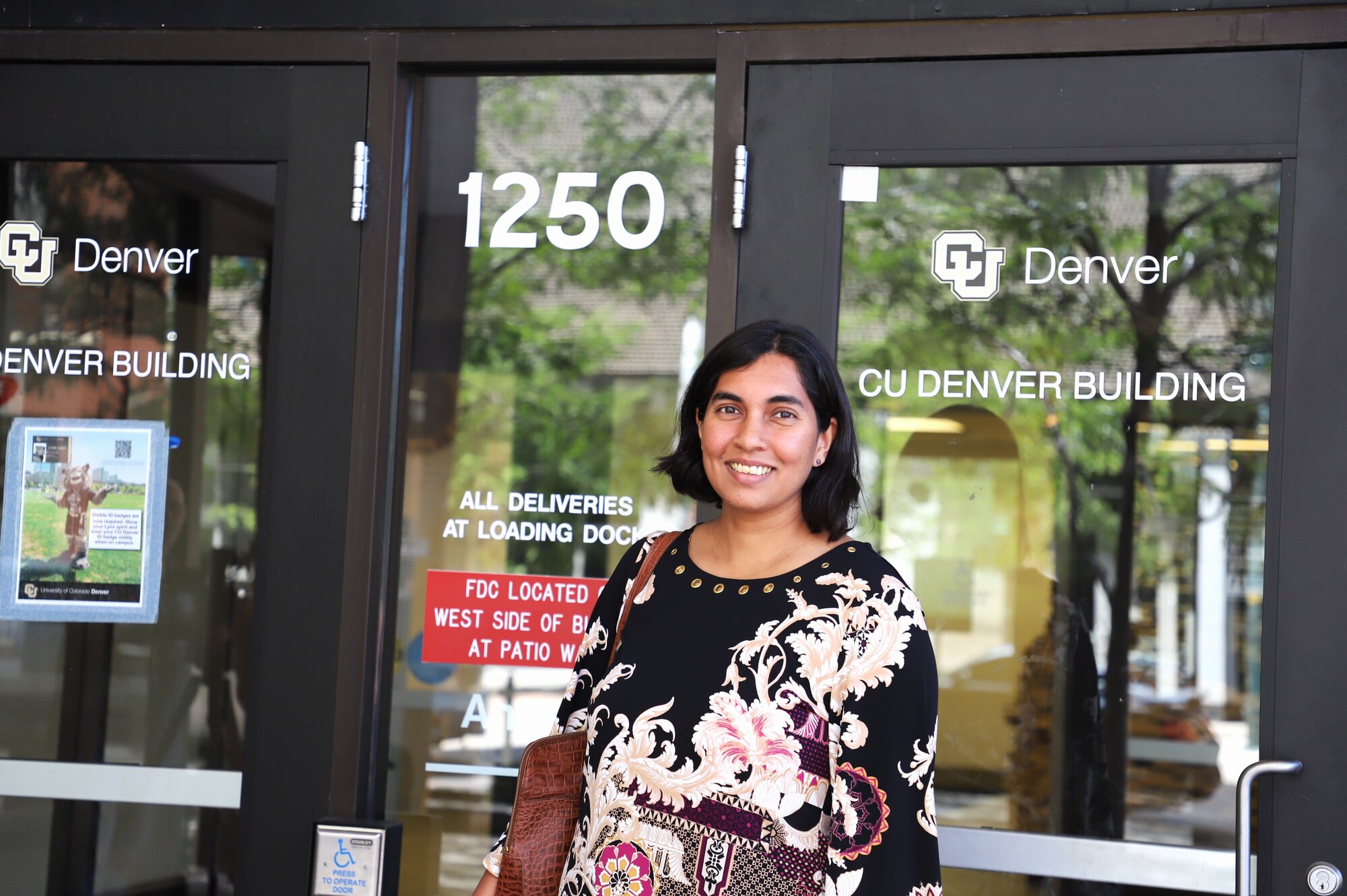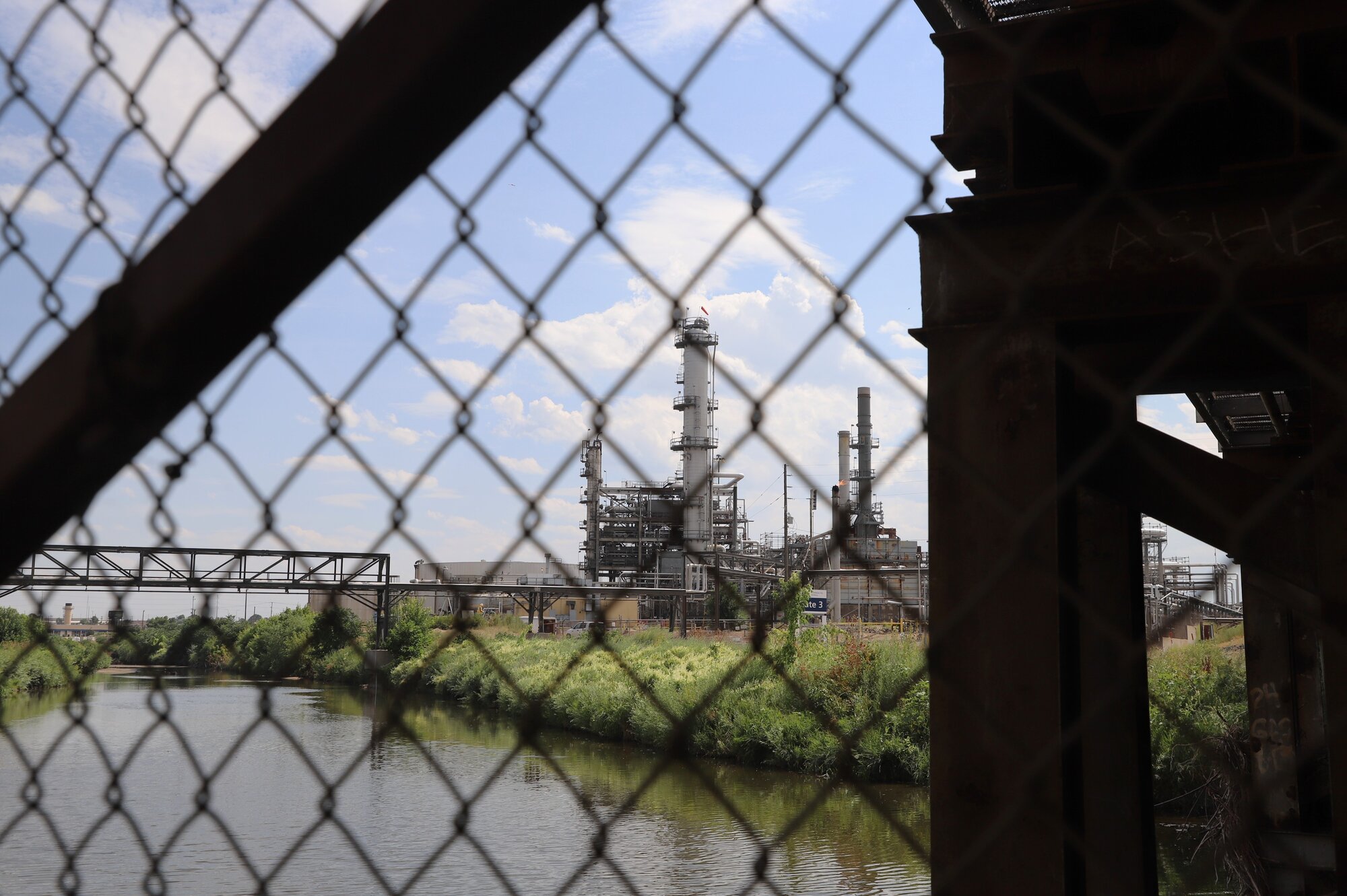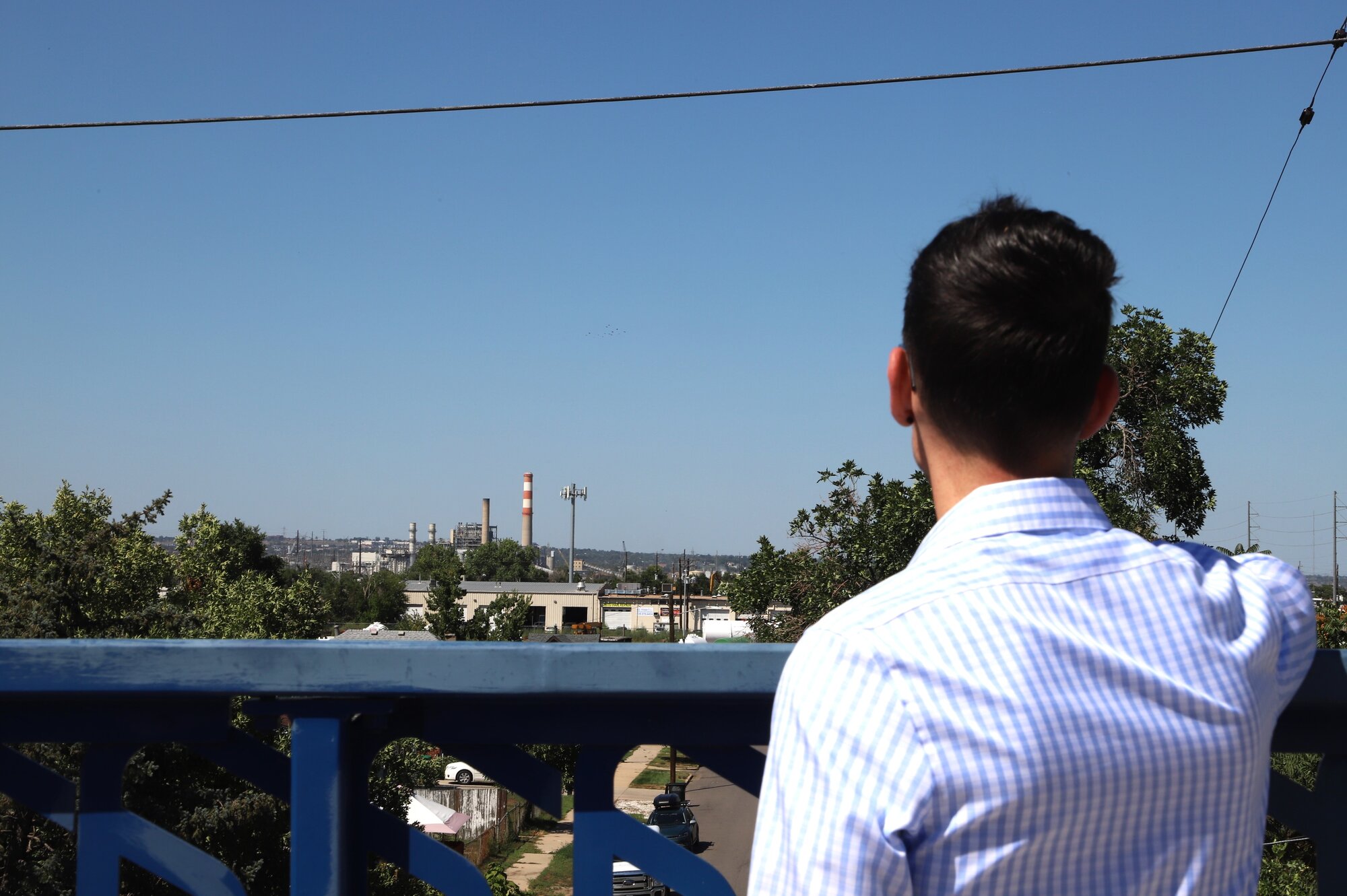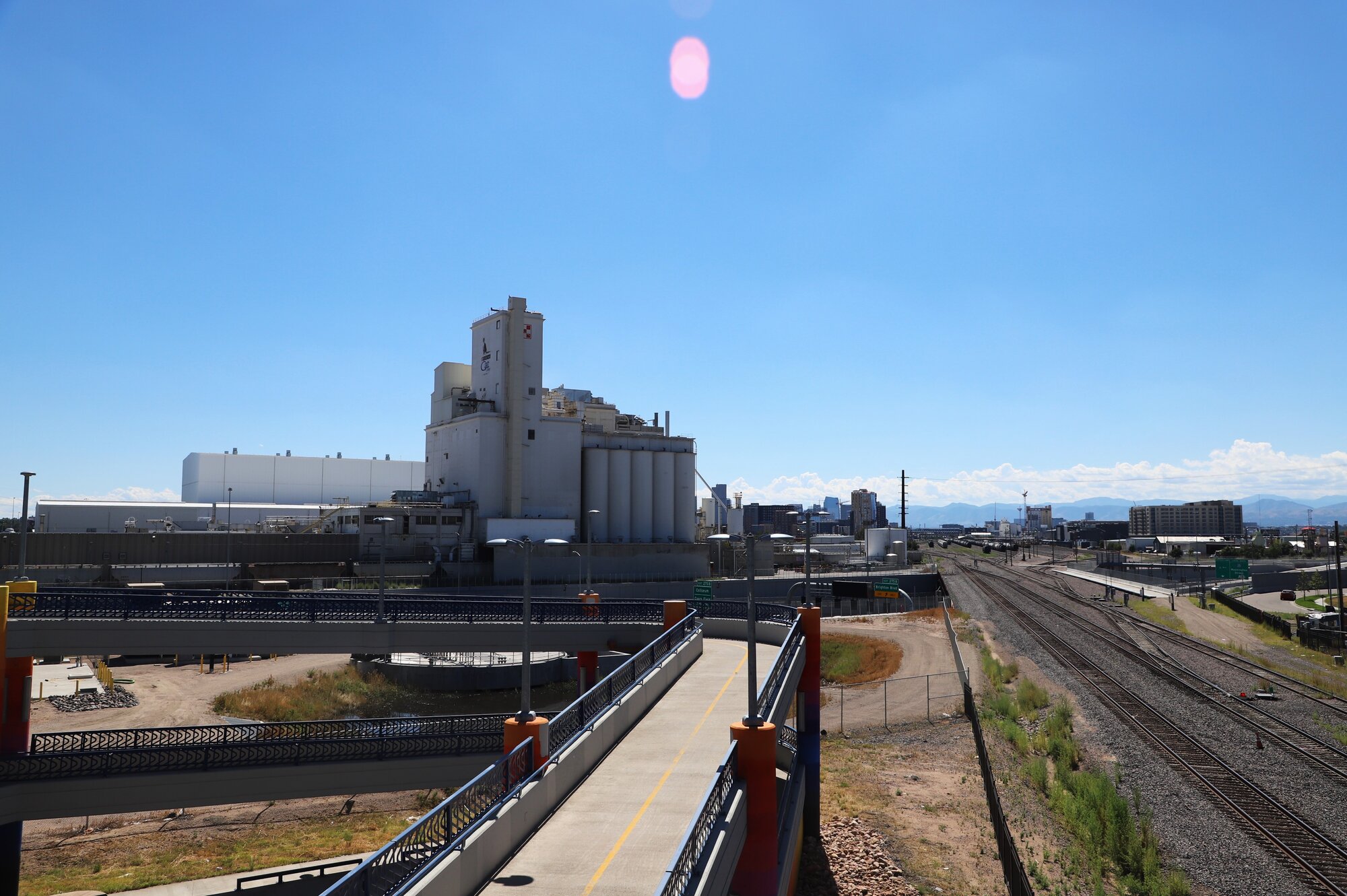EPA settlements with Suncor shed light on decades of environmental injustice in North Denver

This article is part of ongoing reporting and production for a new episode of Colorado Experience called “The Most Polluted Zip Code." It is set to premiere November 9th at 7p.m.
COMMERCE CITY, Colo. — When enjoying a bike path near a flowing creek, one would hope for the chance to catch some fresh air and take in scenic views. But on one path in Commerce City, the sound of water flowing is drowned out by passing cars. The river glows a cartoonish green, and taking a deep breath could mean committing to a headache for the day, thanks to the cocktail of emissions that smell of burnt rubber.
This particular path borders Suncor, a Canadian-owned oil and gas refinery with locations worldwide, including “on hold” facilities in countries like Libya and Syria.
“This is our lives,” said Lucy Molina, gesturing to the refinery behind her. “Imagine breathing this all day every day.”
Molina lives just blocks from the Suncor facilities in Commerce City. She also serves as a member on the board of education. She said years of watching her family suffer from health issues ranging from bloody noses to Leukemia — which she believes were caused by a lack of clean air and water — left her no choice but to dedicate her life to fighting for her family and their community.
“We are a community that lacks. We don't have drinking water. Our air is contaminated. We are getting fracked in the north. And we also are home to one of the biggest polluters in the state of Colorado,” she said.
Molina’s claims of various health issues in her neighborhood are far from unfounded. According to Priyanka deSouza, assistant professor at the Urban and Regional Planning Department at University of Colorado, Denver, there is ongoing research that supports the firsthand accounts of nearby residents.
“Suncor is a major polluter in Adams County and has really affected the health of the community that lives around it,” deSouza explained. “It's very hard to determine causality. But we know that the cancer rates in the community around Suncor are much higher than the cancer rates of the state. And so it's clear that there's something going on in this particular community that is causing these high cancer incidences.”

Priyanka deSouza, PhD, MSc, MBA, MTech studies the impact of environmental inequities in marginalized communities.
As for the argument that Suncor is not the major contributor, and that the health issues are due to smoking or other personal factors deSouza said, “I find that very hard to believe. I believe that Suncor is a major contributor to the variety of diseases that we've seen in the area, specifically because many of the pollutants that Suncor emits we know have been tied to things such as cancer. Benzene, for example.”
Benzene is used as a solvent for many chemicals, including gasoline. According to the Department of Health and Human Services, research has found that “long-term exposure to high levels of benzene in the air can cause leukemia, cancer of the blood-forming organs.”
Benzene is just one of the threats to human health the oil and gas refinery emits. One of the most concerning pollutants, deSouza said, is hydrogen cyanide.

A view of Suncor from the nearby pedestrian path.
“[Suncor] emits more hydrogen cyanide in magnitude than any other source each year, and [hydrogen cyanide] is actually a weapon of war in high concentrations. It can cause difficulty in breathing and all kinds of respiratory effects,” she explained. “It also has an impact in low concentrations.”
Molina has lost multiple loved ones to leukemia, including her grandma. Her children, meanwhile, suffer from bloody noses and asthma in their nearby school. Molina said the children struggle to concentrate.
“We know that air pollution impacts children as well as elderly residents much more than any other populations, and the fact that there's a school near Suncor breaks my heart,” shared deSouza.
Recent EPA Settlements mark a legacy of environmental violations
Since Molina’s last interview with Rocky Mountain PBS, it seems little has changed as far as Suncor’s cooperation with regulations.
In August of this year, the EPA fined Suncor upwards of $300,000 for accident prevention and reporting violations back in 2019. Suncor was instructed to use at least $240,030 on emergency response equipment to help South Adams County’s fire department become more equipped for toxic chemical clean up, and $60,000 in civil penalties.
Regarding the use of civil penalty funds, the EPA commented: "The penalty portion goes to the U.S. Treasury which is then used for government functions. EPA doesn’t track it beyond getting it to the dept of Treasury. Also, EPA receives no funds from administrative penalty actions."
Less than a month later, the EPA ordered Suncor to pay another $760,000 for failing to meet federal standards for reducing ozone pollution during summer months. Part of the money is to be used for additional civil penalties, as well as subsidizing electric lawn and gardening equipment for nearby residents.
These violations are not out of the ordinary for the refinery. They are the latest entry in Suncor’s history of failing to meet environmental standards. Suncor’s Commerce City location alone has been charged with over 58 environment and safety violations since 2005.
Brent Goodlet, a climate and environmental justice advocate for the Green House Connection Center, said that Suncor has also slipped through the cracks when it comes to permitting processes.

Brent Goodlet takes in the view of the Elyria neighborhood, where he advocates for climate justice.
“They [Suncor] violate the Clean Air Act and the clean air laws more than almost any similarly-sized oil refinery in the country,” he explained. “They are constantly exceeding their permitted levels of pollution, even in the state governance realm. The state has laws that say we have to renew the air pollution permits every five years, and Suncor's permit technically hasn't been renewed since 2010.”
“They have spewed these toxins into our communities over and over. And it seems that they only get a slap in the wrist," said Molina.
Experts agree that Suncor pollutes the neighborhood at dangerous levels. The question they are asking, along with residents, is how the refinery continues to get away with it.
Rocky Mountain PBS reached out to Suncor multiple times for comment, but did not receive a response.
Environmental redlining
According to Goodlet, deSouza and Molina, much of this is attributed to Suncor’s location in a low-income, marginalized community.
Goodlet shared that in Denver, there is a long history of redlining in the area that has led to the issues the neighborhood faces today, including the “political disinvestment.”
“North Denver communities used to be part of the metropolitan area in a very cohesive way,” Goodlet said. “Then we decided to build highway I-70 straight through the community, intentionally routing it around richer, whiter neighborhoods and going through areas like Five Points and the more minority-dominated parts of the town.”

Elyria is one of the most polluted neighborhoods in Colorado due to traffic, air pollution, and more.
Goodlet said that this is just one example of these neighborhoods being targeted in ways that have left them facing increasing health and financial disparities.
deSouza, who has focused much of her research on the impact of air quality and climate change on underserved neighborhoods, said that high-pollution facilities are often strategically placed in neighborhoods like the one surrounding Suncor: low-income Black and Brown communities.
“I think places like Suncor make the argument that they are providing jobs to the community. They find it easy to assuage certain members of the community by providing grants to local organizations,” deSouza shared. “Given that communities such as the one around Suncor have sort of been disinvested in by policymakers for so long, the meager resources that Suncor is providing them can be seen as too attractive to give up, and can be used in Suncor's campaign to make themselves seem indispensable.”
To those who haven’t experienced these inequities firsthand, the solution may seem easy or obvious: move to a new part of town... but for many of the residents in the neighborhoods where these facilities are placed, picking up and leaving is simply not an option. Due to the ongoing gentrification of nearby areas, the community is left with no option but self-advocacy.
“What causes climate migration?” said Molina, “Gentrification. It is environmental injustice because people have no choice. “
According to Goodlet, “There's been a concentration of industry placed in this area, and then through redlining and other federal policies where we excluded people of color and low income folks from living in the cleaner parts of town. We forced them all to live next to where the pollution is. And now we've entered into this situation where it's really unsustainable.”
Molina takes this idea a step further, stating the need to accept the history of colonization that led to today’s environmental injustice: “We need to acknowledge first, that we're standing on stolen lands, and have communities that have been trying to protect this land for generations.”
Not just a Denver issue
In the long run, experts say violations like those committed by Suncor don’t just impact the neighborhoods surrounding them. The pollution facilities like Suncor emit significantly contribute to a statewide climate crisis.
“The front range ozone problem is getting worse almost every day in the summer,” explained Goodlet. “Now we have ozone alerts and the Regional Air Quality Council would say we should carpool more, we should fill up our cars after 5 p.m. But really, the single largest contributor to Ozone is oil and gas development.” He continued, “In this case, for Suncor, they are not interested in what is best for the community or best for the environment or the climate crisis for that matter.”
Molina says that the story of Suncor and its impact on the area should serve as a worldwide warning. She encourages others to take a look at the contaminated water, the generations of health issues and disinvestment and consider what will happen if it continues.
“What happens if these things aren’t addressed?” asked Molina, “We're going to just die. The whole humankind. We're going to continue to make communities that are already stricken by poverty, by illnesses, even further down the hole. And when I mean down the hole, that means death.”
The search for solutions
deSouza, Goodlet and Molina agree that the most obvious solution would be for Suncor to move rather than waiting for additional policies to allow the neighbors to relocate.
“That is the big problem, right?” said Molina, “They're still here.”
“Those communities have ties to the area,” added deSouza. “They've lived there all their life. Why should they move? It's a densely populated area. To ask all of these families to move just doesn't make sense to me. I think Suncor needs to move or shut down.”
But Suncor shutting down or moving isn’t the only necessary solution, added deSouza. “It's not just about moving Suncor away from the area, although that's extremely important, but it's also about rectifying these environmental injustices that resulted in Suncor being sited in this community in the first place.”
deSouza, Molina and Goodlet are collaborating with other organizations on various solutions focused in their individual areas of expertise.
“Grassroots organizing is the linchpin to bringing environmental justice to these communities,” said Goodlet.
Molina is currently campaigning to keep her seat on the board of education, where she advocates for leaders and policies that hold entities like Suncor accountable for their actions.
Green House Connection Center recently received a grant from the CDPHE for an Environmental Justice Program for North Metro Denver. Goodlet said the funds will focus on educating and engaging the community on environmental improvements in soil, water and pollution.
“We try to tell folks both about the pollution in their community, but also provide solutions to the pollution problem because folks are constantly being told that their environment is polluted, but then they're not given anything that they can do about it,” he said.
deSouza is collaborating with Cultivando Colorado on developing new air monitoring systems that more precisely measure the pollution in specific areas. deSouza said that the aggregate data currently used for air monitoring leaves areas like the one near Suncor overlooked.
“We will be releasing a study soon where we've looked at the health impacts of pollution in Colorado, where we've looked at block level data and all of a sudden you can see specific hotspots emerge, such as around Suncor,” she said.
Through these studies, the group hopes to advocate for the EPA to adjust their monitoring standards to better account for health disparities in marginalized communities.
While it’s heartening to know there are organizations at work to help ease the climate crisis, in the end, Molina says, our fate is in our own hands.
“As civilians, we need to step it up,” she said. “Our civic responsibility right now is for every human being is to protect this planet for our next generations, because we were part of the problem in creating this climate crisis, and this environmental injustice, by giving entities like Suncor the power.”
*Correction: an earlier version of this story incorrectly identified Molina as a candidate for city council. She is running for the board of education.
Elle Naef is the multimedia producer at Rocky Mountain PBS. You can reach her at ellenaef@rmpbs.org.
Julio Sandoval is the senior photojournalist with Rocky Mountain PBS. You can reach him at juliosandoval@rmpbs.org.
